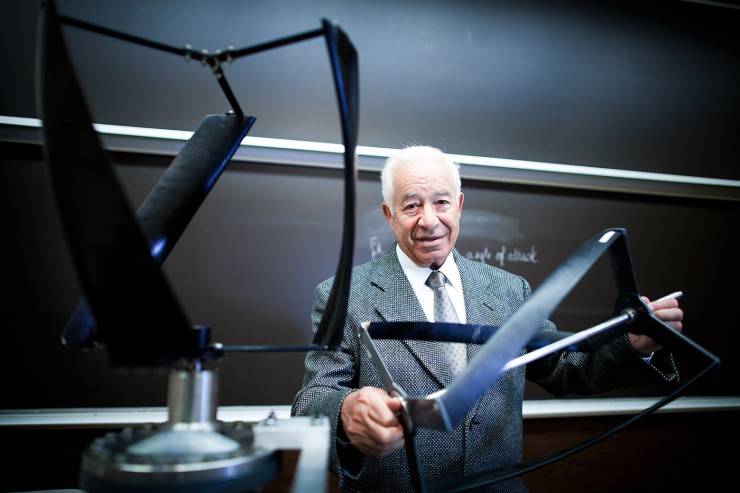Remembering MIE Professor Alexander Gorlov

MIE professor emeritus Alexander Gorlov died in June but left behind a legacy of invention and creativity, including a turbine that garnered him international acclaim.
Source: News @ Northeastern
“I was always impressed by his approach to solving problems,” said Alexander Martsinkovsky, associate professor of mathematics at Northeastern University. “He was a good thinker and he took his time to come up with beautiful solutions.”
Martsinkovsky was reflecting on the life and career of his longtime friend and colleague Alexander Gorlov, professor emeritus of mechanical engineering, who died in June at the age of 85. “People,” he said, “need to know what kind of scientist and engineer he was.”
Gorlov, to be sure, left behind an impressive legacy of invention and creativity, with a particular focus on harnessing hydropower with an eye toward alleviating the worldwide energy crisis. His most prestigious invention—the inexpensive, dam-free, and environmentally friendly Gorlov Helical Turbine, which extracts power from free-flowing currents—won the 2001 American Society of Mechanical Engineers Thomas A. Edison Patent Award and was named one of Popular Science’s top inventions of the year.
The turbine, whose vertical design enables it to extract up to 35 percent more energy from water than the typical horizontal structure, is currently being used to power some 500 homes on the Korean island of Jindo. “The turbine was an absolutely brilliant idea,” said Martsinkovsky, who met Gorlov on Northeastern’s campus in 1990 and later worked as part of a two-person team to help him to compute the turbine’s efficiency. “You could feel a touch of genius there.”
Gorlov himself touted the beauty of the turbine back in 2011, shortly after he was nominated for a European Inventor Award in recognition of his achievement. “My turbine has no negative impact on the environment,” he explained. “Conventional turbines that require dams interfere with migrating fish and other water habitats.”
A ‘chance encounter’
Gorlov was born in Moscow in 1931. His father, a successful lawyer, was arrested and killed in prison during Joseph Stalin’s purges in 1938. His mother, for her part, spent several years in Russian concentration camps, forcing her son to live out some of his childhood in an orphanage in a small town 1,000 miles from Russia’s capital. He earned his bachelor’s degree in bridge and tunnel engineering from the Moscow Institute of Transport Engineers in 1954 and then went on to receive his doctorate in mechanical and structural engineering in 1961 with the goal of building underground tunnels and power stations.
It’s possible to trace Gorlov’s fascination with dam-free hydropower back to the late 50s and early ’60s, when he helped to design Egypt’s Aswan Dam. The construction project tamed the Nile’s floods but also destroyed hundreds of ancient monuments from Egypt’s Pharaonic past, leading him to conclude during a 2001 lecture at Northeastern that the “Construction of massive dams is the evil of conventional hydropower systems.”
I was always impressed by his approach to solving problems. He was a good thinker and he took his time to come up with beautiful solutions.
— Alexander Martsinkovsky, a longtime friend and colleague
Gorlov might have gone on to invent his dam-free turbine in Russia had it not been for an unusual twist of fate on Aug. 12, 1971. It was on that day that Gorlov followed through on a request from his friend Alexander Solzhenitsyn, the Russian novelist and outspoken critic of communism, who had asked him to drop by his cottage to pick up a spare part for his car. When Gorlov arrived, according to his memoir Incident At A Summer House: A Chance Encounter at Solzhenitsyn’s Dacha, the front door was unlocked and a team of about 10 KGB agents was inside. “Gorlov was grabbed, knocked to the floor, dragged face down into the woods and beaten viciously,” according to an open letter from Solzhenitsyn to the USSR’s then minister of state security. The raid’s “senior intruder” issued a firm warning to Gorlov, which he recalled upon reporting the incident to Solzhenitsyn, who then described the scene in his letter: “If Solzhenitsyn finds out what took place at the dacha, you’re finished. Your career will go no further; this will affect your family, your children, and if necessary, we will put you inside.”
Gorlov was branded an anti-Soviet activist, blackballed from academia, and forced to emigrate to the U.S., leaving behind his life in Russia for good. But he ended up making the most of his fresh start, becoming a prolific engineer of international renown. In 1976, he joined the faculty at Northeastern, where he created the Hydro-Pneumatic Power laboratory with the goal of extracting power from tidal energy. He published more than 100 technical papers and books and held 25 patents in fields ranging from structural analysis to theoretical mechanics. One of his inventions—which he dubbed the “Terrorist Truck-Bomb Protection System”—was designed to foil car bombers and was placed on the Department of State’s list of certified equipment. He retired from teaching in 2001, but continued to apply for grants and offer his expertise to student-researchers for the next decade.
“His is a story of resilience and creativity and inventiveness,” said Sheila Puffer, University Distinguished Professor in the D’Amore-McKim School of Business. Puffer interviewed Gorlov in September for her forthcoming book The Soviet Diaspora in the U.S. Innovation Economy: Immigration, Innovation, Imprinting, and Identity, which will chronicle the success of a highly accomplished group of inventors, academics, and entrepreneurs who emigrated from the Soviet Union to the U.S. beginning in the 1970s. “The contributions he made to engineering are highly significant and his will to carry on was remarkable.”